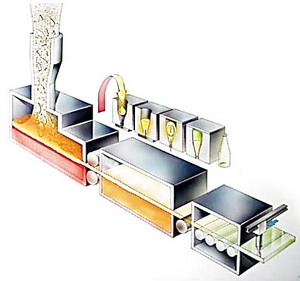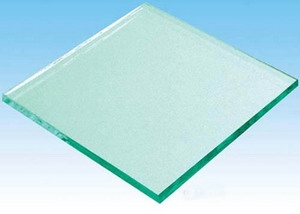การผลิตแผ่นกระจกในปัจจุบัน มากกว่า 90% ผลิตด้วยระบบโฟล้ต (Float Glass Process) ซึ่งพัฒนาขึ้นโดย Sir Alastair Pilkington ชาวอังกฤษ ในปี 1959
โดยการหลอมวัตถุดิบหลักๆ ได้แก่ ทราย (Silica Sand) ยิปซั่ม (Gymsum) โซดาแอช (Soda Ash) และ ไลม์สโตน (Limestone) ที่อุณหภูมิ 1500° C โดยกระจกเหลวจะไหลออกจากเตาหลอมและลอยตัวบนผิวของดีบุกเหลว
 |
FLOAT GLASS PROCESS
The term "float" glass derives from the production method, introduced in the UK by Sir Alastair Pilkington in 1959,
by which process 90% of today's flat glass is manufactured.
The raw materials (soda lime glass, silica sand, calcium, oxide, soda and magnesium) are properly weighted and mixed and then introduced into a furnace where they are melted at 1500° C.
The molten glass then flows from the glass furnace onto a bath of molten tin in a continuous ribbon.
The glass, which is highly viscous, and the tin, which is very fluid, do not mix so that the contact surface between these two materials is perfectly flat.
When leaving the bath of molten tin the glass has cooled down sufficiently to pass to an annealing chamber called a lehr.
Here it is cooled under controlled temperatures, until it is essentially at room temperature.
|
 |
แผ่นกระจกจะค่อยๆเย็นตัวลงขณะที่เคลื่อนตัวผ่านอ่างดีบุกเหลว และเมื่อกระจกแข็งตัวจะถูกนำไปผ่านเตา annealing ซึ่งเรียกว่า lehr และปล่อยให้กระจกค่อยๆเย็นลงจะได้แผ่นกระจกคุณภาพสูง ผิวเรียบสนิท
 |
G |
และด้วยเทคโนโลยี่ปัจจบัน การผลิตกระจกด้วยระบบโฟล้ต สามารถผลิตแผ่นกระจกที่มีความหนาตั้งแต่ 0.3 มม. ถึง 25 มม. |
ในส่วนของอุตสาหกรรมกระจกตกแต่ง และกระจกแปรรูปในเมืองไทย จะใช้ขนาดความหนาตั้งแต่ 2 มม. ถึง 19 มม. โดยจะมีความหนาตามนี้
2mm 8mm
3mm 10mm
4mm 12mm
5mm 15mm
6mm 19mm (22mm,25mm
Float glass is a sheet of glass made by floating molten glass on a bed of molten tin. This method gives the sheet uniform thickness and very flat surfaces. Modern windows are made from float glass.
Most float glass is soda-lime glass, but relatively minor quantities of specialty borosilicate and flat panel display glass are also produced using the float glass process.
The float glass process is also known as the Pilkington process, named after the British glass manufacturer Pilkington, which pioneered the technique (invented by Sir Alastair Pilkington) in the 1950s.
Float glass uses common glass making raw materials, typically consisting of sand, soda ash (sodium carbonate), dolomite, limestone, and salt cake (sodium sulfate).
Other materials may be used as colourants, refining agents or to adjust the physical and chemical properties of the glass.
The raw materials are mixed in a batch mixing process, then fed together with suitable cullet (waste glass), in a controlled ratio, into a furnace where it is heated to approximately 1500°C.
Common flat glass furnaces are 9 m wide, 45 m long, and contain more than 1200 tons of glass. Once molten, the temperature of the glass is stabilised to approximately 1200°C to ensure a homogeneous specific gravity.
The molten glass is fed into a "tin bath", a bath of molten tin (about 3-4 m wide, 50 m long, 6 cm deep), through a delivery canal.[5] The amount of glass allowed to pour onto the molten tin is controlled by a gate.
Tin is suitable for the float glass process because it has a high specific gravity, is immiscible, and is cohesive. Tin, however, is highly reactive with oxygen and oxidises in a natural atmosphere to form Tin dioxide (SnO2). Known in the production process as dross, the tin dioxide adheres to the glass.
To prevent oxidation, the tin bath is provided with a positive pressure protective atmosphere consisting of a mixture of nitrogen and hydrogen.
The glass flows onto the tin surface forming a floating ribbon with perfectly smooth surfaces on both sides and an even thickness.
As the glass flows along the tin bath, the temperature is gradually reduced from 1100°C until the sheet can be lifted from the tin onto rollers at approximately 600°C. The glass ribbon is pulled off the bath by rollers at a controlled speed.
Variation in the flow speed and roller speed enables glass sheets of varying thickness to be formed. Top rollers positioned above the molten tin may be used to control both the thickness and the width of the glass ribbon.
Once off the bath, the glass sheet passes through a lehr kiln for approximately 100 m, where it is further cooled gradually so that it anneals without strain and does not crack from the change in temperature. On exiting the "cold end" of the kiln, the glass is cut by machines.
ผลิตภัณฑ์กระจกตกแต่งอื่นๆ ของ บริษัท ดีดีเอสวี คอนเซ็ปท์ จำกัด



